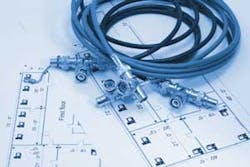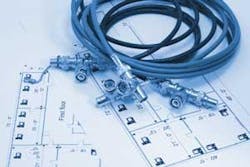Coaxial cabling is still big business
by Betsy Ziobron
Tried-and-true coax persists in many markets and in the data center, despite new twisted-pair standards.
Coaxial cabling, commonly referred to as "coax," has been around for nearly 80 years—its first television transmission being the 1936 Summer Olympics in Berlin. Since then, the use of coax ultimately expanded to dominate today's cable TV market. In fact, coax supports several other applications; the cables are designed with various conductors, insulation, and shields that result in a wide range of physical sizes, performance frequencies, attenuation characteristics, and costs.
With the proliferation of Ethernet andInternet Protocol (IP), some believe coax is on its way out in favor of unshielded twisted-pair (UTP) for several key applications. But most agree coax will persist for quite some time.
A home-run advantage
Coaxial cable features a center conductor (solid orstranded) surrounded by a dielectric insulating layer, which in turn is surrounded by a shield (braid, foil, or both) and then a protective outer jacket, usually made of polyvinyl chloride (PVC). Highly resilient to signal interference and with the frequency range to support multiple channels, a large installed base of 75-Ω coaxial delivers cable TV in the last mile to more than 112 million U.S. subscribers.
Coax cabling's ability to support multiple channels enables allocating channels for high-speed Internet access, which is how cable TV providers have been able to compete as Internet Service Providers. Coaxial cable also offers high bandwidth per channel and low noise and crosstalk, which makes it the medium of choice for delivering high-definition video to and within the home. Within the home, short coaxial cables are used to connect equipment, such as TVs, DVRs, VCRs, or CATV and satellite receivers.
In the residential market, coax will remain the medium of choice for entertainment interconnects within the home. When it comes to delivering TV service to the home from the curb, or in a multi-unit/room facility, most experts believe it will be decades before any significant amount of coaxial cabling is replaced with UTP to deliver IPTV service.
"It's going to be difficult to displace coax in the TV service market," says Mike Barnick, business development manager for Systimax (www.systimax.com)."Fiber is coming to the curb, but it's not always goingto the home. Coax is still a great media to get fromthe curb to the house, and the cable TV providers are doing an excellent job with it."
But some video applications in the commercial environment are experiencing a shift. "For commercial environments that need to deliver entertainment video to several rooms, such as hotels or hospitals, coax is still the media of choice," Barnick says. "But in video surveillance systems that have traditionally been deployed with coax, we're starting to see a shift to IP video using twisted-pair cabling."
In fact, twisted-pair cabling is already a major contender in video surveillance systems, with reduced cabling and installation costs and the flexibility of distributing IP-based cameras across a network that can be accessed from anywhere in the world.
"In the past, you needed coax to support cameras with pan, tilt, and zoom capabilities, but now we can run Power over Ethernet with twisted-pair to enable pan, tilt, and zoom," says Barnick. "As devices become more intelligent, and technology evolves, we see twisted-pair and IP technology gaining ground for many applications, including some of those traditionally supported by coax."
A circuit scenario
Although it doesn't receive much attention, coax is deployed within the commercial data center environment for supporting E-1/T-1 and E-3/T-3 circuits coming from a central office to a service provider demarcation in the data center's entrancefacility. Coax is then used to extend those circuits to core switches, where it is typically converted to fiber and/or UTP. In April, the TIA published Addendum 1 to the ANSI/TIA-942 Telecommunications Infrastructure Standard for Data Centers, which specifically addresses data center coax cabling specifications and applications distances.
According to Jonathan Jew, vice chairman of TR-42.6 and president of J&M Consultants, Inc. (www.j-and-m.com),Addendum 1 to TIA-942 specifies additional requirements for connectors and testing for 75-Ω coax cabling, provideslonger horizontal coax cabling originating from the maindistribution area in the data center, and amends E-1/T-1and E-3/T-3 maximum circuit distances primarily due toreduced attenuation for the 75-Ω coax connectors.
"Customers still use 734-type [75-Ω] coax cabling in thedata center if they need to support T-3 circuits for any con-siderable distance, but the quantities are not large," says Jew. "For shorter distances, baluns and thinner 735-type coaxialcable are adequate. And once you get into extremely long circuits, optical fiber and optical fiber converters are necessary."
Jew adds, "The exact distances for the coax depends on several factors, including the number of intermediate connections, type of circuit, type of UTP, and type of baluns if used. The quantity of coax deployed in this application depends on the number of E-1/T-1 and E-3/T-3 circuits expected, but it isn't a large number in most data centers."
In the data center, coaxial-type cabling is also deployed for connecting servers and switches over short distances inserver-cluster, virtualization, and storage systems. InfiniBand technology, a high-speed, low-latency interconnect architecture that is primarily used for interconnects between servers, uses twinaxial, or twinax cable.
Same but different
"There's coax and there's twinax, and many people use the term coax to cover them both," says Ed Cady, strategic marketing director for Meritec (www.meritec.com). "Coax has one conductor, but twinax has two conductors either in the same dielectric or each with their own dielectric around it. The distances used for InfiniBand applications are relatively short, up to about 30 meters, primarily for connecting server-to-server, server-to-SAN [storage area network], or server-farm-to-Ethernet switch."
InfiniBand has captured a market niche for high-speed connections between servers and switches due to its ability to support10 Gbits/sec and higher, low latency for moving data packets from one node to another, and its low power consumption and associated cooling needs.
"People who buy servers are pretty locked into InfiniBand, just like they are primar-ily locked into Ethernet for communications and Fibre Channel and SCSI for storage," says Cady. "InfiniBand offers higher reliability over Ethernet, which can lose packets, and it doesn't take much power to run an InfiniBand chip. Ethernet is trying to bring its performance up to InfiniBand standards, so there's a continuous race going on."
Cady adds, "InfiniBand proponents would love to see their technology take over, but Ethernet is so huge and in so many market segments, that's not likely to happen."
InfiniBand twinax cables require factorytermination to maintain the smoothest geometry for high-speed transmission, but Cady points out that most data center designers can easily map out theircable lengths, and many prefer preterminated solutions anyway. "Early on, fiber-optic terminations were extremely difficult, and it took years of development to improve the process," he says. "We havethat same progression potential with twinax solutions."
Commonly used for stacking switches in the data center, the 10GBase-CX4 (IEEE 802.3ak) protocol is another coax application for transmitting 10-Gigabit Ethernet. This lower-cost switching technology transmits 10 Gbits/sec using four transmitters and four receivers over four bi-directional lanes, with each pair transmitting at 3.125 Gbits/sec over a twinax cable. 10GBase-CX4 supports cable lengths of up to 15 meters, which is adequate for most data center applications. Active embedded chips in the plug can also increase the distance limitation up to three times.
"We found that we needed 10 Gig in the data center, but also needed a low-cost way to deploy it, which is where CX4 came in," says Systimax's Barnick. "Twinax has shielding, so alien crosstalk isn't an issue. It's cheaper than using fiber for short distances, and it's really been the primary choice until Augmented Category 6 came along."
He believes CX4 is essentially a temporary solution for running 10 Gbits/sec over copper cabling. As standards are ratified, the power required for UTP switches comes down, and data center managers look to improve flexibility, thetwinax cabling and CX4 standard will be replaced by UTPand the 10GBase-T standard in similar applications.
"In 2007, a 24-port UTP switch for 10 Gig was almost10 watts per port; now we're down to six, and in anotheryear, that could be cut in half again," predicts Barnick."Moreover, the 15-meter limitation with CX4 doesn't provide much flexibility, and most data center managers arecomfortable with UTP. Consequently, we're now seeing UTP cabling rise above twinax for these applications."
On the other hand, Cady sees twinax in the data center as very common and continuing to grow: "40-Gig and 100-Gig standards are currently being developed for twinax, which will prolong its use for many years to come."
A lasting medium
Coaxial cabling has a place in many other applications, including: electronic, test, and management equipment for many market segments; distributed antenna systems; radio transmission systems; satellite/GPS systems; and space and military applications. And while some see it going by the wayside in favor of UTP for certain networking applications, coax will continue to be deployed in central offices, cable TV networks, and server farms for years to come.
"Coax is still big business," sums Barnick. "Over time, it may lose prominence in some of its key applications, but that will require mass acceptance and new technologies in those areas. And if we continue to need more bandwidth and higher speeds, fiber may eventually be the media of choice that takes over."
Cady points out that, "It's very tribal. Everyone is in love with their own technology. Ethernet is dominating and pushing out beyond the LAN and WAN through the industrial network, instrumentation, and sensor systems. So ultimately, Ethernet has the best buying power."
He adds, however, that "you really have to look at each situation and application independently, and there are advantages with coax that will continue to dominate for awhile, including new applications in several market segments."
BETSY ZIOBRON is a freelance writer and regular contributor to Cabling Installation & Maintenance. She can be reached at: [email protected]

